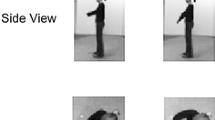Abstract
In 3-D object recognition in human, the recognition performance across viewpoint changes is divided into 2 types: viewpoint-dependent and viewpoint-invariant. We analyzed the viewpoint dependency of objects under the theory of image-based onject representation in human brain (Poggio & Edelman 1990, Tarr 1995) using Support Vector Machines (Vapnik 1995). We suggest from such computational approach that the features of object images between different viewpoints are major factors for human performance in 3-D object recognition.
Access this chapter
Tax calculation will be finalised at checkout
Purchases are for personal use only
Preview
Unable to display preview. Download preview PDF.
Similar content being viewed by others
References
Biederman, I.: Recognition-by-components: A theory of human image understanding. Psychological Review 94 (1987) 115–147
Biederman, I, Gierhardstein, P.C.: Recognition depth-rotated objects: Evidence and conditions for threc-dimensional vicwpoint invariance. J. Experimental Psychology: Human Perception and Performance 19 (1993) 1162–1182
Bülthoff, H.H., Edelman, S.: Psychophysical support for a two-dimensional view interpolation theory of objecl recognition. Proc. Natl. Acad. Sci. USA 89 (1992) 60–64
Hayward W.G., Tarr. M.S.: Testing conditions for viewpoint invariance in object recognition. J. Experimental Psychology: Human Perception and Performance 23 (1997) 1511–1521
Hummel, J.E., Biederman, I.: Dynamic binding in a neural network for shape recognition. Psychological Review 99 (1992) 480–517
Johnstone, M.B., Hayes, A,: An experimental comparison of viewpoint-specific and viewpoint-independent models of object representation. The Quarterly Journal of Experimental Psychology 53A (2000) 792–824
Logothetis, N.K., Pauls, J., Bülthoff, H.H., Poggio, T.: View-dependent object recognition by monkeys. Current Biology 4 (1994) 401–414
Marr, D., Nishihara, H.K.: Representation and recognition of the spatial organization of three-dimensional shapes. Proc. R. Soc. Lond. B 200 (1978) 269–294
Poggio, T., Edelman, S.: A network that learns to recognize three-dimensional objects. Nature 343 (1990) 263–266
Saunders, C., Stitson, M.O., Weston, J., Bottou, L., Schoelkopf, B., Smola, A,: Support Vector Machine-Reference manual. Technical Report CSD-TR-98-03, Department of Computer Science, Royal Holloway, University of London, Egham, UK (1998)
Tarr. M.J.: Rotating objects to recognize them: A case study on the role of viewpoint dependency in the recognition of three-dimensional objects. Psychonomic Bulletin & Review 2 (1995) 55–82
Tarr, M.J., Bülthoff, H.H.: Image-based object recognition in man, monkey, and machine. Cognition 67 (1987) 1–20
Tarr, M.J., Bülthoff, H.H., Zabinski, M., Blanz, V.: To what extent do unique parts influence recognition across changes in viewpoint? Psychological Science 8 (1997) 282–289
Tjan, B.S., Legge, G.E.: The viewpoint complexity of an object recognition task. Vision Research 38 (1998) 2335–2350
Ullman, S., Barsi, R.: Recognition by linear combination of models. IEEE Trans. Pattern Analysis and Machine Intelligence 13 (1991) 992–1006
Vapnik, V.N.: The Nature of Statistical Learning Theory. Springer-Verlag, New York (1995)
Author information
Authors and Affiliations
Editor information
Editors and Affiliations
Rights and permissions
Copyright information
© 2001 Springer-Verlag Berlin Heidelberg
About this paper
Cite this paper
Hayasaka, T., Ohnishi, E., Nakauchi, S., Usui, S. (2001). Analysis on the Viewpoint Dependency in 3-D Object Recognition by Support Vector Machines. In: Mira, J., Prieto, A. (eds) Bio-Inspired Applications of Connectionism. IWANN 2001. Lecture Notes in Computer Science, vol 2085. Springer, Berlin, Heidelberg. https://doi.org/10.1007/3-540-45723-2_21
Download citation
DOI: https://doi.org/10.1007/3-540-45723-2_21
Published:
Publisher Name: Springer, Berlin, Heidelberg
Print ISBN: 978-3-540-42237-2
Online ISBN: 978-3-540-45723-7
eBook Packages: Springer Book Archive




